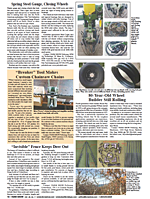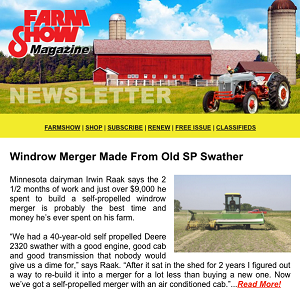Power Units Boost Tractor Power
 ✖  |
Sam Hill and Justin Dennis designed the Denhill Twin-Pull for seasonal high horsepower needs. The auxiliary power pack consists of tandem 64-hp. engines and rear ends. It hooks up to a conventional tractor drawbar, increasing the horsepower available to pull implements by 128 hp. Hill, a Norfolk (U.K.) farmer, and Dennis, a Norfolk civil engineer, developed their prototype as an alternative to ever larger and more expensive tractors. Freelance writer Chris Lockwood detailed their efforts in an extensive article in the December 2023 issue of Classic Tractor.
“Our goal was to make better use of available tractors without investing in expensive horsepower only needed for limited periods,” says Hill.
It’s a challenge the two have been working on for several years. Their first attempt involved joining two crawler tractors together with a tow chain. The operator sat on the one in the rear and controlled the steering, clutch, and throttle of both.
Their next attempt involved a tractor that sat on the front linkage of a second tractor. The idea was to pick the first tractor up when turning, but it proved too heavy.
The Denhill Twin-Pull was their most successful attempt yet. They invested 200 hrs. of time to harness the two David Brown 995 skid units repurposed from David Brown-based Sands forward control sprayers.
The skid units mount side-by-side in a heavy-duty frame that measures 23 1/2 ft. from the lead tractor drawbar to the implement drawbar. The 5 by 12-in. I-beam at the center of the frame has an 88-in. rear cross member and a 108-in. front cross member. The Twin-Pull weighs in at about 8,000 lbs. with about 2,000 lbs. resting on the lead tractor’s drawbar. It measures 12 ft. side to side.
The Twin-Pull’s wheels are set to straddle the lead tractor’s tracks. This ensures each of the drive wheels gets undisturbed ground to bite into and spreads the weight out, notes Hill.
Preparing for field work involves manually selecting gears in the Twin-Pull transmissions. Stops on the throttles are set for idle and working speeds. When the operator is ready to start tillage, clutches and throttles are engaged remotely with spool valves. At headlands, clutches are disengaged as the implement is lifted out of the soil.
A key safety component of the frame is the sliding drawbar that connects the Twin-Pull to its lead tractor. If the power pack starts to move up on the tractor, tension on cables that control the throttles is reduced, and the power pack backs off.
This past summer, it was demonstrated at several field days. In September, Hill used it behind his 154-hp. 1988 Ford TW-25 (the lead tractor) at a local plowing day. It was the first time it had been put to the test.
“We didn’t use the full power of either the Twin-Pull or the lead tractor as the discs we were pulling didn’t require it,” says Hill. “We wanted to use the Twin-Pull as much as possible to prove the contribution it could make. Had the load been greater, the combination of units would have met the challenge, and driving would actually have been easier.”
Hill acknowledges that the prototype is very much proof of concept and was done at a low cost. He recognizes it could be significantly improved. To date, no one has stepped forward to do so.
“We used what we had,” says Hill. “If I built another version, it would be much larger, at least 200 hp. Engine throttles would be paired and controlled electronically from the cab. I would replace the sliding drawbar with a kill switch in the cab and the I-beam with a box beam. This would shorten the overall length, which would help on headland turns.”
Contact: FARM SHOW Followup, Sam Hill, Barn Owl Farm, Rush Green, Barnham Broom, Norwich, Norfolk, United Kingdom NR9 4EA (ph 44 788 178 6690; samghill536@gmail.com).

Click here to download page story appeared in.
Click here to read entire issue
Power Units Boost Tractor Power ENGINES Sam Hill and Justin Dennis designed the Denhill Twin-Pull for seasonal high horsepower needs The auxiliary power pack consists of tandem 64-hp engines and rear ends It hooks up to a conventional tractor drawbar increasing the horsepower available to pull implements by 128 hp Hill a Norfolk U K farmer and Dennis a Norfolk civil engineer developed their prototype as an alternative to ever larger and more expensive tractors Freelance writer Chris Lockwood detailed their efforts in an extensive article in the December 2023 issue of Classic Tractor “Our goal was to make better use of available tractors without investing in expensive horsepower only needed for limited periods ” says Hill It’s a challenge the two have been working on for several years Their first attempt involved joining two crawler tractors together with a tow chain The operator sat on the one in the rear and controlled the steering clutch and throttle of both Their next attempt involved a tractor that sat on the front linkage of a second tractor The idea was to pick the first tractor up when turning but it proved too heavy The Denhill Twin-Pull was their most successful attempt yet They invested 200 hrs of time to harness the two David Brown 995 skid units repurposed from David Brown-based Sands forward control sprayers The skid units mount side-by-side in a heavy-duty frame that measures 23 1/2 ft from the lead tractor drawbar to the implement drawbar The 5 by 12-in I-beam at the center of the frame has an 88-in rear cross member and a 108-in front cross member The Twin-Pull weighs in at about 8 000 lbs with about 2 000 lbs resting on the lead tractor’s drawbar It measures 12 ft side to side The Twin-Pull’s wheels are set to straddle the lead tractor’s tracks This ensures each of the drive wheels gets undisturbed ground to bite into and spreads the weight out notes Hill Preparing for field work involves manually selecting gears in the Twin-Pull transmissions Stops on the throttles are set for idle and working speeds When the operator is ready to start tillage clutches and throttles are engaged remotely with spool valves At headlands clutches are disengaged as the implement is lifted out of the soil A key safety component of the frame is the sliding drawbar that connects the Twin-Pull to its lead tractor If the power pack starts to move up on the tractor tension on cables that control the throttles is reduced and the power pack backs off This past summer it was demonstrated at several field days In September Hill used it behind his 154-hp 1988 Ford TW-25 the lead tractor at a local plowing day It was the first time it had been put to the test “We didn’t use the full power of either the Twin-Pull or the lead tractor as the discs we were pulling didn’t require it ” says Hill “We wanted to use the Twin-Pull as much as possible to prove the contribution it could make Had the load been greater the combination of units would have met the challenge and driving would actually have been easier ” Hill acknowledges that the prototype is very much proof of concept and was done at a low cost He recognizes it could be significantly improved To date no one has stepped forward to do so “We used what we had ” says Hill “If I built another version it would be much larger at least 200 hp Engine throttles would be paired and controlled electronically from the cab I would replace the sliding drawbar with a kill switch in the cab and the I-beam with a box beam This would shorten the overall length which would help on headland turns ” Contact: FARM SHOW Followup Sam Hill Barn Owl Farm Rush Green Barnham Broom Norwich Norfolk United Kingdom NR9 4EA ph 44 788 178 6690; samghill536@gmail com
To read the rest of this story, download this issue below or click
here to register with your account number.







